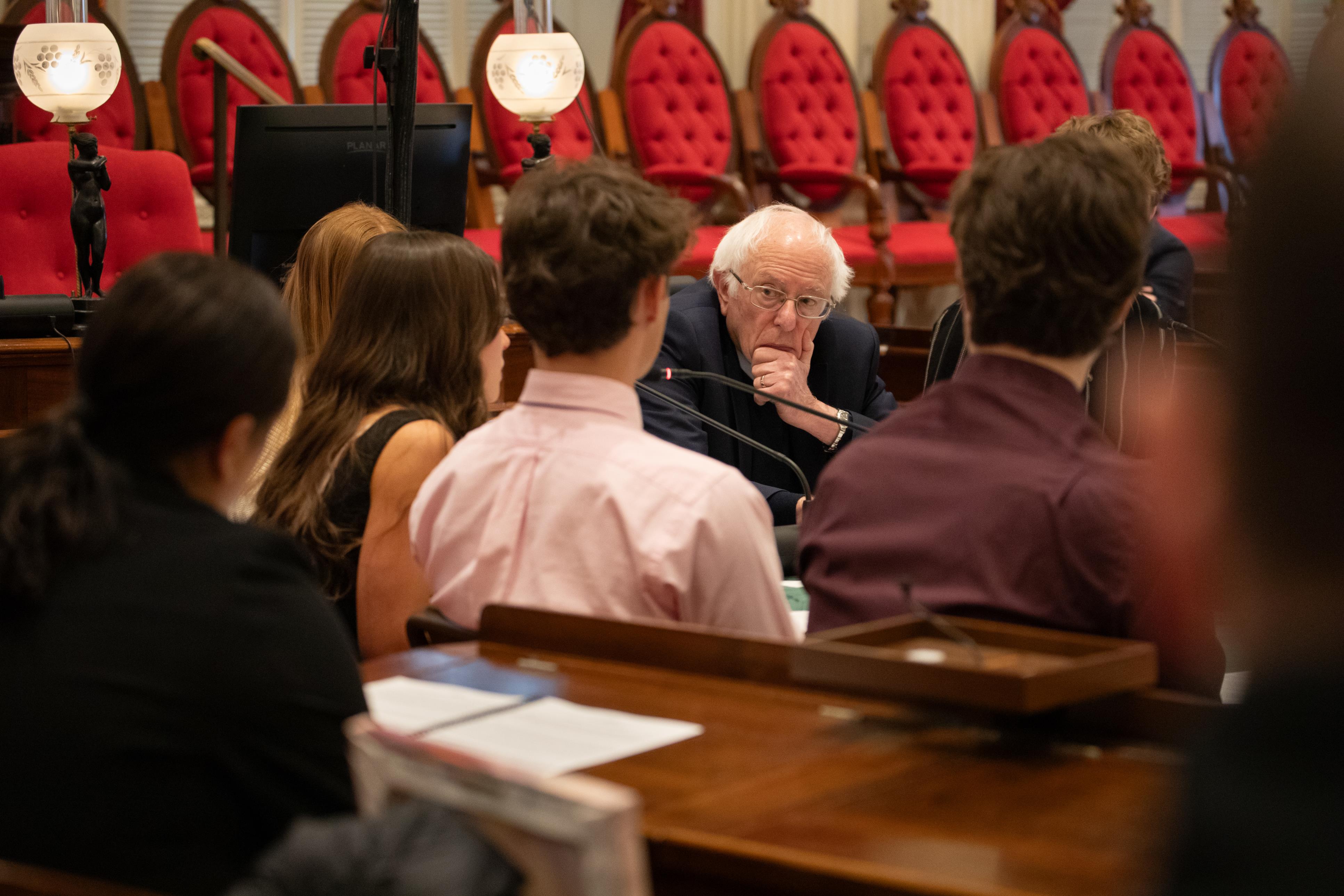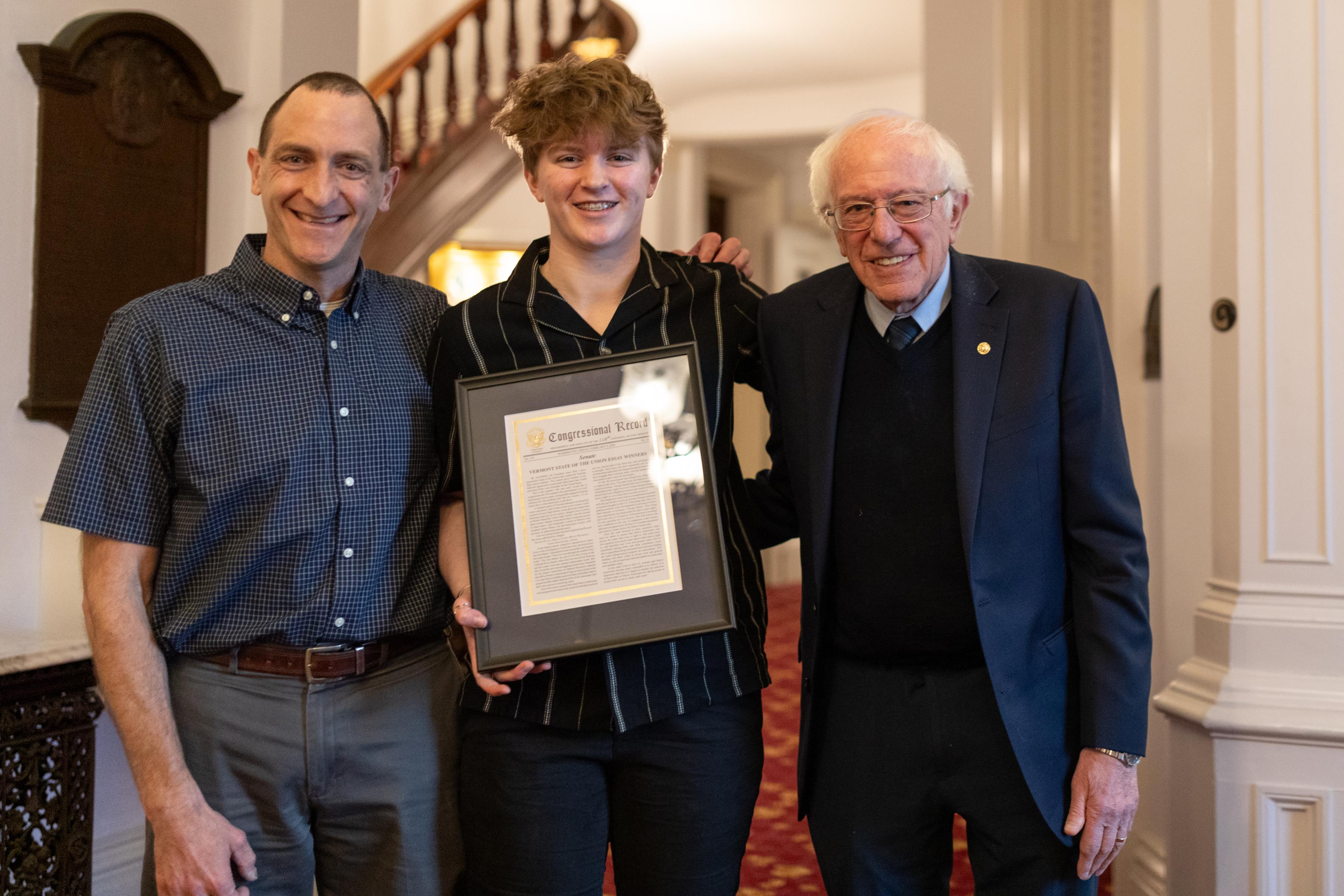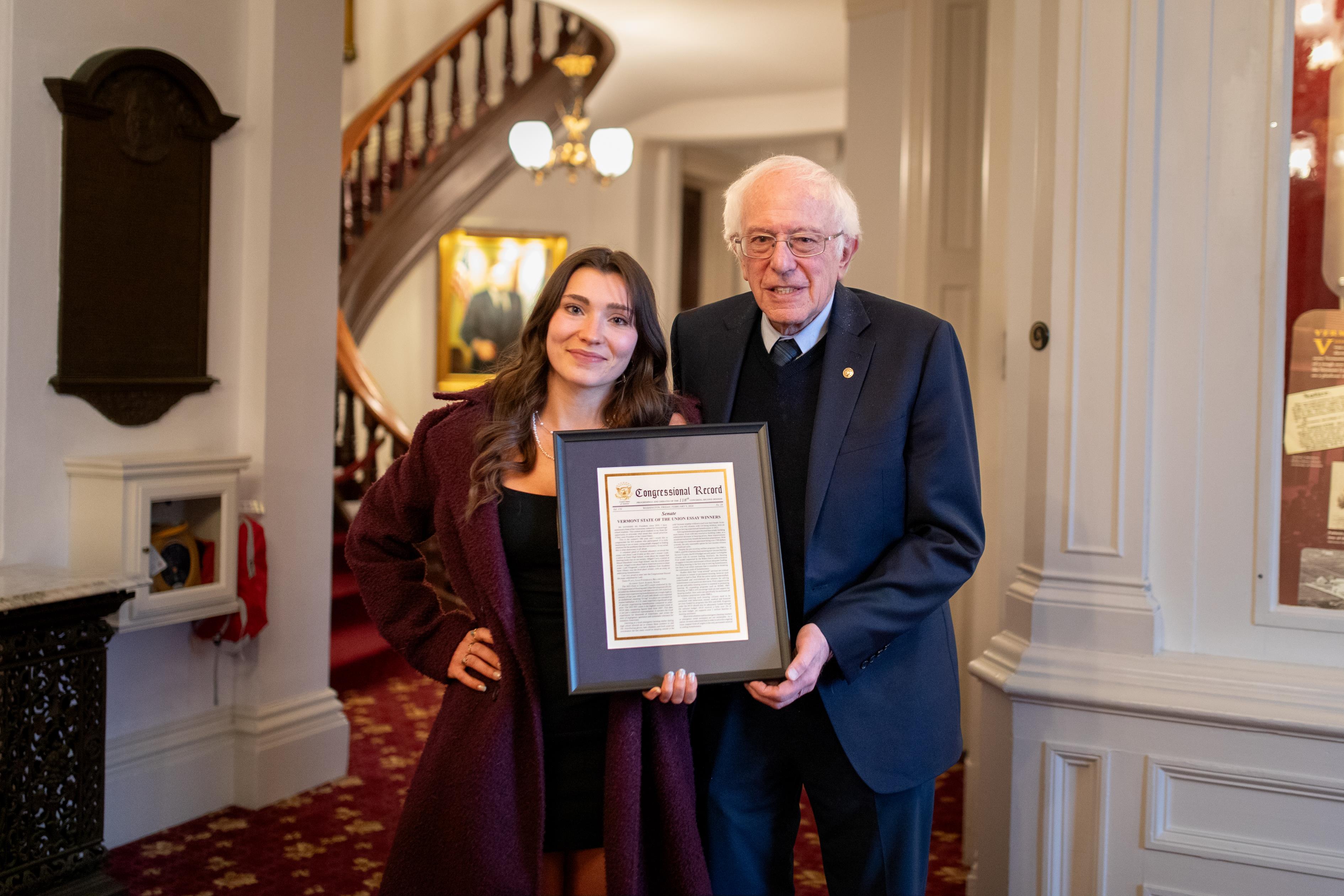|

|
|
Young Vermonters on the
“State of Our Union” |
|
Dear Fellow Vermonter,
On the Thursday before last, I listened to President Biden deliver his annual State of the Union address in Washington. Two days later, at the State House in Montpelier, I got to hear a different kind of State of the Union: from 13 young Vermonters from all across our state.
For the past 14 years, I have held a State of the Union essay contest for Vermont high school students. The reason we do this contest is to give young Vermonters an opportunity to take a look at some of the major problems facing our country and practice thinking about how they might go about fixing them – if they were the President of the United States.
|
|
.jpg)
|
|
Every year, I am impressed by the thoughtful essays we receive and every year I look forward to the roundtable discussion I have with the finalists.
This year was no different. 454 students from 27 Vermont high schools submitted essays this year, and I got to sit down with the finalists whose essays were determined best by a group of independent judges.
In their essays and during our discussion, we covered many issues including: the high cost of housing, access to mental health care, political polarization, gun safety, Indigenous water rights, disability rights, racial justice, homelessness, banned books and censorship, funding for education, flooding in Vermont and climate change, overdose prevention and substance use disorder, corporate greed, and money in politics.
|
|

|
|
No doubt about it. This generation of young people is living through tough times and these are tough topics. But by discussing these issues and possible solutions, it is my hope that they will know at least one thing: They are not alone in this fight to address these crises.
I hope you take a moment to read the students’ essays, all of which were published in the Congressional Record. The top three winning essays are included below and you can read all of the finalists' essays here.
Sincerely,

|
|
.jpg)
|
|
1st Place: Leah Frisbie
Junior, Essex High School |
|
.jpg) |
|
Books are foundational to our society, as self-discovery is enhanced through reading about different characters, cultures, and perspectives and finding similarities within it all. Books have the power to transform lives, tell important stories, and spread information. As each year more and more books are pulled from library shelves, the opportunities provided are reduced. The banning of books in the United States is a pressing problem that deprives people across the country from perspectives, information, and freedom.
In recent years, the removal of books from school libraries has exponentially increased in the United States. According to The New York Times, "The PEN report, which counted book removals in school and classroom libraries during the 2022-2023 school year, found 3,362 cases of books being removed, a 33 percent increase over the previous school year." The majority of banned books target topics relating to gender identity, racial justice, and sexuality. Through attempts to ban books, marginalized groups' stories and perspectives are silenced. The act of banning books diminishes the quality and purpose of education. With the absence of diverse stories shared, the population becomes less educated, and marginalized groups will continue to be underrepresented. When students aren't exposed to diverse stories, ignorance, hate, and fear rise.
The Hate U Give by Angie Thomas is a book that tells the true story of a young girl facing racism and its correlation to police brutality in the US. Although it is a heavy topic, it accurately addresses the reality and problems of our society. It communicates someone's life experiences, yet is widely banned in school libraries due to its portrayal of racism and anti-police views. The Hate U Give is a single example out of thousands of books, where underrepresented groups' stories, history, and truth is restricted from the public.
In order to stop the escalation of banned books, Congress must pass the Fight Banned Books Act that was introduced in December of 2023. The act provides funding to school districts to fight against the banned book crisis. Currently, many schools do not have the budget to defend banned books, resulting in a surge of books being pulled from shelves. With the act, The Department of Education would dedicate $15 million over five years to school districts to help assist in the costs, including retaining legal representation, travel to hearings on bans, and maintaining expert research. By passing the Fight Banned Books Act, school districts across the nation would play a fundamental role in decreasing banned books and spreading awareness.
Congress must pass the Fight Banned Books Act in order to protect the nation from the needless deprivation of information. The issues occurring in society, such as gender and race inequalities, deserve to be shared in libraries. While the intention of removing books from shelves is to protect students, it is doing the complete opposite: Students' education, freedom, and exposure to different perspectives is deprived.
|
|
2nd Place: Abigail Curry
Junior, Mount Mansfield Union High School |
|
 |
|
In the Mojave desert, along the Colorado River, there lives a tribe of indigenous Americans who call themselves the Aha Makav. Translated as best as possible into English, this name means "The river runs through the middle of my body." The Aha Makav are one of 30 tribes living in the Colorado River Basin, where the river has all but dried up and the water crisis has reached catastrophic levels. But they're not the only ones struggling to find water. Research by the House Committee on Natural Resources showed that 48% of Native Americans living on reservations in the U.S. don't have a reliable source of clean, drinkable water-a proportion 80x higher than the 0.6% of all Americans who don't have access to drinking water.
Part of the issue's cause is that when Native Americans were assigned reservation land, much of what they received was dry, barren land in the West that were predisposed to drought. They have also been repeatedly left out of infrastructure and utility development projects that would have brought them running water, leaving hundreds of thousands to haul water by the bucket. So far, the government has refused any obligation to improve the issue. This past June, the Supreme Court ruled in Arizona v. Navajo Nation that even if Indigenous tribes have treaty rights to a river's water, the government doesn't have any obligation to assess how much of it they have a right to, or to help them actually access it.
The indigenous water crisis is a complicated issue that will only get harder to solve as climate change continues to worsen droughts in the U.S. That being said, there is a path to a solution. First, the Supreme Court must overturn their decision in Arizona v. Navajo Nation. This ruling was a significant step backwards for native water rights, but it was only a 5-4 majority. If the decision is revisited, it's very possible for it to reverse. This will remove the new roadblock in the way of indigenous water access, and open an opportunity for the U.S. to make reparations and improve water access for Native Americans.
Once the road forward is clear, proactive steps must be taken to ensure that Native Americans can access the water they have a right to. The court must first quantify how much water native tribes have a right to, and therefore how river and ground water will be distributed among tribes and other consumers. Once this is quantified, the government must increase funding for water infrastructure projects on reservations. This funding will allow tribes to access river and ground water, as well as opening treatment plants to create their own potable water.
As the water crisis in the U.S. worsens and Native Americans become more vulnerable to its effects, it is imperative that the U.S. begins to remedy the centuries of harm done to Native Americans by taking action to ensure their access to clean, safe water.
|
|
3rd Place: Leah Fitzgerald
Senior, Bellows Free Academy – Saint Albans |
|
 |
|
The 2023 Point in Time (PIT) count conducted by the U.S Department of Housing and Urban Development (HUD) revealed the disheartening truth that over 653,104 American citizens were experiencing homelessness on a single night in January of last year. 40% of such individuals were reported as unsheltered, meaning "living" in a place not intended for human habitation. 41 U.S. states reported a significant surge of persons experiencing homelessness compared to years prior. The 2023 PIT count is the highest recorded count in HUD data, surpassing figures back from 2007.This data is not just a statistical representation: it narrates the lived experiences for thousands of Americans, and writes the story of negligence, ignorance and systematic tolerance for homeless Americans.
Interning at a local emergency housing shelter during high school allowed me to witness these numbers in real life. Distributing gloves, hats, blankets, and food could not overshadow the fact many would be sleeping outside in the cold Vermont weather without a roof over their heads. In my county, over 462 citizens, with 114 being children, were on record as having experienced homelessness in 2023.
Solving homelessness goes beyond than simply building more homes. Even with less restrictive building codes, or a substantial decrease in housing prices, these improvements would not exclusively benefit the homeless populations. With the average two-bedroom apartment being over 1700 dollars a month, the only reasonable option for low-income citizens is subsidized units. Despite the pre-existing welfare programs like PBRA, TBRA, and FRA that have been assisting low-income families for over 75 years, the HUD budget can only assist 1 in 4 eligible citizens with its current funding. Similarly, the Housing First model supported by the Biden-Harris administration struggles to become mainstream without adequate funding.
Providing housing is the first step to solving homelessness, but there is an entire staircase that is essential to breaking the continuous cycle of homelessness. Studies show that "wrap around" services are critical for citizens to remain in permanent housing, however such support is hard to find. With the entire nation understaffed, underfunded and overwhelmed the solution for solving homelessness is not quick nor short term.
First, support to the private and public housing sectors is essential to promoting housing. By expanding programs such as HOME, PRO Housing, or TBRA will encourage land use and support the housing market. New units can specifically be sectioned off for homeless populations under PBRA. Upon entering such housing, citizens need to be connected with behavioral, mental, medical and financial services funded by programs like SSA and HHS. Programs under the HUD should also be adequately funded through the national budget. HUD receives a little over 1% of the total budget, yet supports over 3 million families in housing assistance.
Short term solutions such as emergency housing vouchers or emergency rental assistance are not sustainable. As a nation, we must understand that in order to solve this ongoing issue, support from all angles is the only permanent solution to ending homelessness.
|
|
How Can We Help?
My Vermont offices have experienced caseworkers on staff who help Vermonters navigate federal agencies every day. If you think my office can help, please do not hesitate to call 1-800-339-9834 or click here.
If you would like to share your thoughts on pending legislation, or if you have an idea that we could address through new legislation, click here.
Receiving this email as a forward? Click here to sign up for the Bernie Buzz. |
|
|
|
|
 
|
|